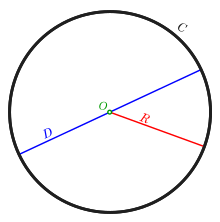球の半径 円の周囲 C (黒); 直径 D (水); 半径 R (赤); 中心(原点)O (紫) 古典的な幾何学 では円 や球 の半径 (英 : radius [ 注 1] 周囲 へ渡した任意の線分 や、その長さ である。
これは「光線」や「輻 」を意味するラテン語 : radius に由来し、一点からあらゆる方向へ放射状に延びる線分 (あるいは半直線 (ray))を表している[ 2]
半径を文字で置くときは radius の頭文字をとった省略形の r とするのが典型的である。この省略形は1569年 にピエール・ラムス (英語版 ) [ 3]
半径を二倍に延長して直径 の大きさ d を得る。つまり、
d
:=
2
r
(
⟹
r
=
d
2
)
{\displaystyle d:=2r\qquad (\implies r={\frac {d}{2}})}
[ 4] 周長 (円周 の長さ)C の円の半径は
r
=
C
2
π
{\textstyle r={\frac {C}{2\pi }}}
正多角形 に対しては、単にその半径 (radius) と言った場合には外半径 (外接円 の半径)の意味である[ 5] 内接円 の半径)は辺心距離 と言う。
中心を持たない幾何学的対象の場合には、最小包含半径 (「最小包含円」や「最小包含球 (英語版 )
図形の内半径 (inradius) はふつうその図形に含まれる円(または球)の最大半径の意味であるが、日常語として輪っか (ring) や筒 (tube) などの中空物体の内半径 (inner radius) は、その空洞部分の半径の意味で用いる。
グラフ理論 においてグラフの半径 (radius) は、グラフの各頂点 u から測ったほかの頂点までの最大距離の u を任意の頂点を亙って動かしたときの最小値と定義される[ 6]
様々な図形に対し、半径は矛盾なく定義できて、その図形の他の部分の測度と何らかの関係性を持つ。
面積 が A であるような円 の半径は
r
=
A
π
{\displaystyle r={\sqrt {\frac {A}{\pi }}}}
同一直線上 にない三点 P 1 , P 2 , P 3
r
=
|
O
P
1
→
−
O
P
3
→
|
2
sin
θ
(
θ
=
∠
P
1
P
2
P
3
)
{\displaystyle r={\frac {|{\vec {OP_{1}}}-{\vec {OP_{3}}}|}{2\sin \theta }}\qquad (\theta =\angle P_{1}P_{2}P_{3})}
正弦定理 に用いられる。
さらに、三点の座標が具体的に (x 1 , y 1 ), (x 2 , y 2 ), (x 3 ,y 3 ) と与えられているならば、上式は
r
=
[
(
x
2
−
x
1
)
2
+
(
y
2
−
y
1
)
2
]
[
(
x
2
−
x
3
)
2
+
(
y
2
−
y
3
)
2
]
[
(
x
3
−
x
1
)
2
+
(
y
3
−
y
1
)
2
]
2
|
x
1
y
2
+
x
2
y
3
+
x
3
y
1
−
x
1
y
3
−
x
2
y
1
−
x
3
y
2
|
{\displaystyle r={\frac {\sqrt {[(x_{2}-x_{1})^{2}+(y_{2}-y_{1})^{2}][(x_{2}-x_{3})^{2}+(y_{2}-y_{3})^{2}][(x_{3}-x_{1})^{2}+(y_{3}-y_{1})^{2}]}}{2|x_{1}y_{2}+x_{2}y_{3}+x_{3}y_{1}-x_{1}y_{3}-x_{2}y_{1}-x_{3}y_{2}|}}}
小さい n に対する Rn
n
R n
3
0.577350...
4
0.707106...
5
0.850650...
6
1.0
7
1.152382...
8
1.306562...
9
1.461902...
10
1.618033...
n = 4
一辺の長さ s の正 n -角形の半径 r は
r
=
R
n
s
(
R
n
:=
1
2
sin
(
π
n
)
)
{\displaystyle r=R_{n}s\qquad {\Bigl (}R_{n}:={\frac {1}{2\sin({\frac {\pi }{n}})}}{\Bigr )}}
n に対する Rn の値を右の表にまとめておく)。
s = 1Rn それ自身が対応する正 n -角形の半径を与えている。
d -次元超立方体 の一辺の長さが s ならば、その半径は
r
=
s
2
d
{\displaystyle r={\frac {s}{2}}{\sqrt {d}}}
特別に固定された一点から放射状に走る半直線 という意味での radius は動径 と呼ばれ、平面や三次元空間あるいはより一般の空間において、いくつかの座標系の構成成分の一つになる。例えば、動径成分が一定であるような点の軌跡は、円や球面を掃く。
極座標系は、平面 上の各点 が特別に固定された点からの距離 と特別に固定された方向から測った角度 によって決定される、二次元 の座標系 である。(直交座標系 における原点 に対応する)固定された点はこの座標系の極 (pole ) と言い、固定された方向へ極から出る半直線 を極線 (polar axis ; 極軸), 原線 (primitive axis ) または始線 (initial axis ) という。極からの距離を動径座標 (radial coordinate ) あるいは動径 (radius ) などと呼び、極線から測った角を偏角座標 (angular coordinate )、極角 (polar angle ) あるいは方位角 azimuth ) などと呼ぶ[ 7]
円筒座標系では、基準となる固定された軸とその軸に直交する基準平面が存在する。この座標系の「原点」は基準軸と基準面との交点を言い、三つの座標成分すべてを零としたときの点として指定することができる。
基準面上では原点を極とする極座標系が入っており、その極座標系に関する極線 が基準面上にあるから、基準面に直交する基準軸はそれと区別するために、円筒軸 (cylindrical axis ) や緯線軸 (longitudinal axis ) などと呼ぶが、基準面を水平面と考えるときには縦軸 、基準面を垂直面と考えるときには横軸 や前後軸 のようにも呼び、名称は様々である。
円筒軸からの距離を動径距離 (radial distance ) や動径 (radius ) と言い、円筒軸回りの偏角座標をしばしば角度位置 (angular position ) や方位角 azimuth ) と呼ぶ。考えている点を通り基準面に平行な平面上で、動径と方位角は二次元の極座標系 を定めるから、動径成分と方位角成分を併せて「極座標成分」(polar coordinates ) と呼ぶ。残る第三の成分は、緯度 (longitudinal position [ 8] 軸位置 (axial position .[ 9] 高さ (height ) や高度 (altitude ) などとも呼ぶ。
球面座標系では、動径 の大きさは固定された原点からの距離を記述するものになる。この座標系での点の位置は、動径成分以外に、固定された天頂方向 (zenith direction ) から動径方向へ測った極角である天頂角 (zenith angle ) と、原点を通り天頂方向に直交する基準平面上への動径方向の直交射影と基準平面上の基準方向の成す角である方位角 azimuth angle ) で決まる。
^ 複数形は radii (ラテン語式)だが、稀に英語式で radiuses とすることもある[ 1]
^ “Radius - Definition and More from the Free Merriam-Webster Dictionary ”. Merriam-webster.com. 2012年5月22日 閲覧。 ^ Definition of Radius at dictionary.reference.com. Accessed on 2009-08-08.^ 黒木哲徳『なっとくする数学記号』講談社〈ブルーバックス〉、2021年、32頁。ISBN 9784065225509 。 ^
Definition of radius at mathwords.com. Accessed on 2009-08-08.
^ Barnett Rich, Christopher Thomas (2008), Schaum's Outline of Geometry , 4th edition, 326 pages. McGraw-Hill Professional. ISBN 0-07-154412-7 , 978-0-07-154412-2 . Online version accessed on 2009-08-08.
^ Jonathan L. Gross, Jay Yellen (2006), Graph theory and its applications . 2nd edition, 779 pages; CRC Press. ISBN 1-58488-505-X , 9781584885054 . Online version accessed on 2009-08-08.
^ Brown, Richard G. (1997). Andrew M. Gleason. ed. Advanced Mathematics: Precalculus with Discrete Mathematics and Data Analysis . Evanston, Illinois: McDougal Littell. ISBN 0-395-77114-5 ^ Krafft, C.; Volokitin, A. S. (1 January 2002). “Resonant electron beam interaction with several lower hybrid waves” . Physics of Plasmas 9 (6): 2786–2797. Bibcode : 2002PhPl....9.2786K . doi :10.1063/1.1465420 . ISSN 1089-7674 . オリジナル の14 April 2013時点におけるアーカイブ。. https://archive.is/20130414005110/http://pop.aip.org/resource/1/phpaen/v9/i6/p2786_s1?isAuthorized=no 9 February 2013 閲覧r ,θ ,z ) ... and Z=vbz t is the longitudinal position..." ^ Alexander Groisman and Victor Steinberg (1997), Solitary Vortex Pairs in Viscoelastic Couette Flow . Physical Review Letters, volume 78, number 8, 1460–1463. doi :10.1103/PhysRevLett.78.1460 "[...]where r , θ , and z are cylindrical coordinates [...] as a function of axial position[...]"
Weisstein, Eric W. "Radius" . mathworld.wolfram.com (英語). radius in nLab radius PlanetMath .(英語) Definition:Radius at ProofWiki BSE-3 (2001), “Radius” , in Hazewinkel, Michiel, Encyclopedia of Mathematics ISBN 978-1-55608-010-4 , https://www.encyclopediaofmath.org/index.php?title=Radius BSE-3 (2001), “Radius vector” , in Hazewinkel, Michiel, Encyclopedia of Mathematics ISBN 978-1-55608-010-4 , https://www.encyclopediaofmath.org/index.php?title=Radius_vector 





![{\displaystyle r={\frac {\sqrt {[(x_{2}-x_{1})^{2}+(y_{2}-y_{1})^{2}][(x_{2}-x_{3})^{2}+(y_{2}-y_{3})^{2}][(x_{3}-x_{1})^{2}+(y_{3}-y_{1})^{2}]}}{2|x_{1}y_{2}+x_{2}y_{3}+x_{3}y_{1}-x_{1}y_{3}-x_{2}y_{1}-x_{3}y_{2}|}}}](https://wikimedia.org/api/rest_v1/media/math/render/svg/729326b799ed2cc75478ab6d68a6be083991b0bc)


